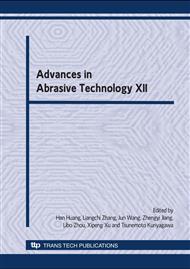p.560
p.566
p.571
p.577
p.585
p.591
p.597
p.603
p.609
Towards Improving Rock Cutting Tools Using Thermally Stable Diamond Composites
Abstract:
Industrial application of synthetic diamond ceramics is growing very fast due to their super hardness, superb wear resistance and long-life durability. In rock, concrete and metal cutting, drilling, mining and quarrying and dimension stone industries, cutting tools made of diamond composites or impregnated diamond composite segments are gradually replacing the more commonly used cemented tungsten carbide (WC) tools. Through its SMARTCUT research program, CSIRO in the past 15 years has developed harder and stronger thermally stable diamond composite (TSDC) drag picks to encourage and help manufacturing and mining industries improve their cutting performance by replacing these traditional WC cutting tools with the new revolutionary TSDC tools. This improvement process however is much more complex than a simple material or cutting tool replacement, since the mechanism and configuration of cutting are substantially different in the two cutter head systems and its successful implementation requires a better understanding of the basics of rock cutting. Some of the factors influencing the differences are: cutter wear, fracture toughness, compressive and tensile strength, thermal properties, geometrical shape, spacing, angle of attack, rake angle, sharpness and bluntness characteristics, lacing design and cutter arrangements. Besides, it is most important to understand the relation between the tool or tool force and the fragmentation of the rock, which is the main focus of this paper.
Info:
Periodical:
Pages:
585-590
Citation:
Online since:
June 2009
Authors:
Price:
Сopyright:
© 2009 Trans Tech Publications Ltd. All Rights Reserved
Share:
Citation:


